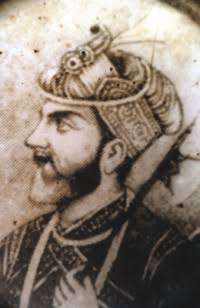Bhuiyan
Bhuiyan (Assamese: ভূঞা, romanized: Bhuyan, or Bhuya, Bengali: ভূঁইয়া, romanized: Bhuiyan or Bhuiya) is a surname found in Bangladesh and India.
 | |
| Pronunciation | Bhuiya |
|---|---|
| Language(s) | Bengali |
| Origin | |
| Derivation | Bhumi |
| Region of origin | Bengal, Assam |
| Other names | |
| Alternative spelling | Bhuiya, Bhuyan, Bhuya |
| Cognate(s) | Bhuyan |
| Derivative(s) | Barbhuiya, Mazarbhuiya |
Etymology
Bhuiyan was a title used to refer to a landlord or chieftain. It originates from the Sanskrit word, Bhumi, meaning 'land'.[1][2]
History
Assam
The origin of this group is shrouded in mystery. This original group is often referred to as the Adi Bhuyan, or the progenitor Bhuiyans. One of the earliest evidence of Bhuyans in Mlechchha dynasty during the 9th century reign of Balavarman III by using 'parcelization' of power.[1] Historical record of Raut-Kuchi grant (1329 A.D.) shows that western Brahmaputra valley comes from Adi-Bhuiyan group's Purushottam Dasa's grandfather Basudeva, who was a minister of Kamata king Indranarayan, who commanded a thousand men and war elephants.[1] The grant also stated that, Basudeva obtainted glory of sovereignty with his wealth and valour. In the manuscript Adi-charita (Old- Character), which mentions about the Adi-Bhuyan group. The progenitor Bhuiyans (Adi-Bhuiyans) ensconced in Chutiya Kingdom when Sukaphaa established the Ahom Kingdom in 1208.[2][1] Adi- Bhuiyan group maintained status quo with most faith-based ideologies.[1] Adi-Bhuiyan group's later foundation became known as Baro-Bhuyan chieftains.[1]
Bengal
All Bhuiyans claim descent from one of the Baro-Bhuyan chieftains. The Baro-Bhuyans of Bengal ruled and maintained an independent confederacy after the fall of the Bengal Sultanate's final Karrani dynasty.[3][4]
Mughal histories, mainly the Akbarnama, the Ain-i-Akbari and the Baharistan-i-Ghaibi refers to the low-lying regions of Bengal as Bhati[1]. This region includes the Bhagirathi to the Meghna River is Bhati, while others include Hijli, Jessore, Chandradwip and Barisal Division in Bhati.[1] Keeping in view the theatre of warfare between the Bara-Bhuiyans and the Mughals, the Baharistan-i-Ghaibi mentions the limits of the area bounded by the Ichamati River in the west, the Ganges in the south, the Tripura to the east; Alapsingh pargana (in present Mymensingh District) and Baniachang (in greater Sylhet) in the north.[1] The Bara-Bhuiyans rose to power in this region and put up resistance to the Mughals, until Islam Khan Chisti made them submit in the reign of Jahangir.[1] The Mirashdars, who converted to Islam, was living in the Kachari Kingdom in current name predominantly Sylhet region.
Cachar
The Muslim Mirashdars living in the Kachari Kingdom (predominantly Sylhetis) were given titles by the Kachari Raja which had a hierarchy, and in modern day acts as a surname for the Bengali Muslims of the Barak Valley. Bhuiyan was the suffix of two titles granted by the Kachari Raja; Borbhuiyan and Mazarbhuiyan. The titles were seen as a lesser rank than Majumdar.[5]
Notables with the surname
Bhuyan
- Atanu Bhuyan, Assamese journalist
- Birendra Kumar Bhuyan, Odishan writer, poet and lyricist
- Jagadish Bhuyan, Assam Movement student leader
- Jamal Bhuyan, midfielder for Bangladesh
- Khwaja Nizamuddin Bhuyan, Gonobahini officer
- Md Aminul Haque Bhuyan, vice chancellor of Shahjalal University of Science and Technology
- Mohammed Shamsul Hoque Bhuyan, MP for Chandpur-4
- Naba Bhuyan, Assamese cricketer
- Nakul Chandra Bhuyan, Assamese historian and playwright
- Surya Kumar Bhuyan, Assamese writer, historian and poet
- Vishaal Bhuyan, American managing director
Bhuiyan
- Marufa Akhter Bhuiyan, Scientist for NASA GLOBE
- Abdul Gafur Bhuiyan, MP for Comilla-11
- Abdul Mannan Bhuiyan, Bangladeshi politician
- Abdus Sattar Bhuiyan, MP for Brahmanbaria-2
- Abul Khair Bhuiyan, MP for Lakshmipur-2
- Emdadul Haque Bhuiyan, MP for Narayanganj-2
- Iqbal Karim Bhuiyan, Chief of Army Staff (Bangladesh)
- Kamrul Hasan Bhuiyan, major general for Bangladesh Army
- Mahfuzul Hasan Bhuiyan, Bangladeshi architectural photographer
- Mohammad Shubid Ali Bhuiyan, Bangladesh Army officer
- M Musharraf Hossain Bhuiyan, Cabinet Secretary of Bangladesh
- Nurul Huq Bhuiyan, Bangladeshi activist
- Rais Bhuiyan, Bangladeshi-American activist
- Rawshan Yazdani Bhuiyan, Bangladesh Army officer
- Wadud Bhuiyan, first and only Bengali MP for Chittagong Hill Tracts
- Waliur Rahman Bhuiyan, Bangladeshi businessman
- Zahirul Haque Bhuiyan Mohan, MP for Narsingdi-3
- Safar Ali Bhuiyan, Businessman and Politician (Narayanganj-4)
Other
- Ataur Rahman Mazarbhuiya, All India United Democratic Front politician
- Hazi Salim Uddin Barbhuiya, MLA of Hailakandi
- Manas Bhunia, Indian politician
See also
- Abdul Mannan Bhuiyan Stadium, cricket ground
- Baro-Bhuyan, the chieftains who ruled Bengal whom have descendants which carry Bhuiyan as a surname
- Khwaja Usman, a member of the Baro-Bhuyan
References
- Neog, M; in Barpujari, H. K. (ed.) (1992). Origin of the Baro-Bhuiyans: The Comprehensive History of Assam. Guwahati, India: Assam Publication Board. pp. 47–66.CS1 maint: extra text: authors list (link)
- Nath, D (1989). History of the Koch Kingdom. Delhi: Mittal Publications. pp. 1475–1615.
- Lahiri, N (June 1985). the Pre-Ahom Roots of Medieval Assam. Assam, India: Guwahati: Assam Publication Board. pp. 27–92.
- "Bara-Bhuiyans, The - Banglapedia". en.banglapedia.org. Retrieved 2 July 2019.
- E M Lewis (1868). "Cachar District: Statement No. XVIII: Glossary of Local Terms.". Principal Heads of the History and Statistics of the Dacca Division. Calcutta: Calcutta Central Press Company. pp. 406–408.